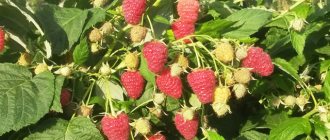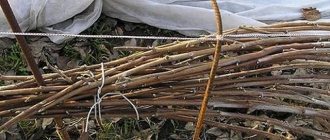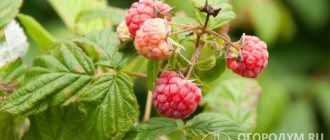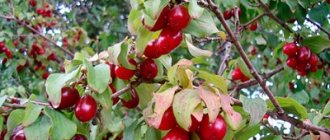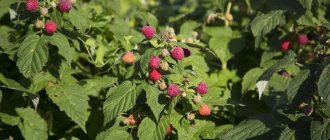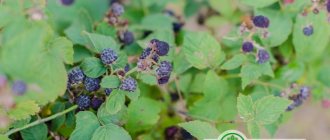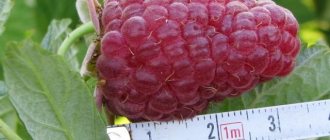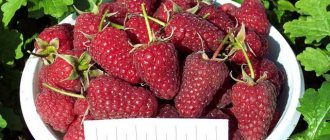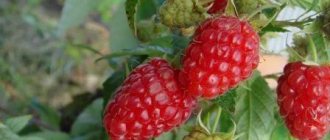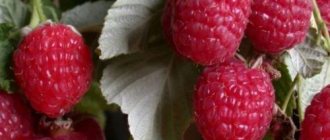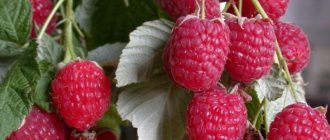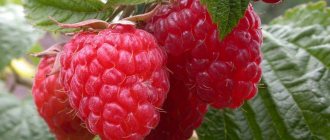The remontant raspberry Ruby Necklace surprises with its yield - 158 c/ha. The variety is mid-season, so it is more suitable for regions with long and warm autumns. When growing, it is worth considering one feature: an impressive number of berries are formed on low and thin shoots.
- 2 Description of the variety
2.1 Video: Ruby necklace in a fruit nursery
- 2.2 Advantages and disadvantages of raspberry Ruby necklace - table
- 3.1 Video: one way to plant raspberries is in a hole filled with humus
- 4.1 Video: five-minute raspberry jam
Description of Raspberry Ruby Necklace
Raspberries of the “Ruby Necklace” variety are characterized by high transportability and productivity. It is well suited for growing for sale. The plant is remontant, that is, it can bear fruit 2 times a year.
Ruby necklace propagates well through the formation of cuttings. The berries have an average ripening period. They come in regular shape, slightly elongated. The weight of the fetus ranges from 4 to 6 grams, in some cases reaching 8 grams. The color is bright, scarlet. The berries taste sweet and sour. The tasting score in various sources ranges from 3.8 to 4.5 points out of 5. The pulp is particularly tender. The fruits are suitable for various processing, making jams and preserves, even deep freezing.
Fruiting occurs predominantly on one-year-old shoots; they are more productive. The variety of this plant itself is characterized by high yield.
Selectors stated that one bush produces on average 2.5 kg of berries, and one hectare – up to 15 tons! The beginning of ripening is mid-August. Before the first frost, almost the entire crop usually has time to ripen.
The fruits are located throughout most of the plant itself. The height of the stem reaches 1.5 meters. The plant itself is characterized as slightly spreading. New cuttings appear with average intensity, there are about 7 of them at normal times. To prepare planting material, there are various techniques to increase the appearance of cuttings up to 20 pieces. The shoots that appeared this year turn a bright purple color in the fall. The spikes also take on this color. Stems that are more than a year old are brown and become straight. The spikes are located along the entire length and have a downward curved shape. The leaves are also medium in size, almost even. The branches that bear fruit are usually located on the sides. They have a coating of wax on them. The flowers are not large in size and have a high amount of fluff.
Description of the variety
Many gardeners who want to grow juicy and tasty berries in their garden are interested in the description of the Ruby Necklace raspberry. This is a medium-height, well-developed plant. The height of the shoots reaches 1.85 m. Old shoots of the plant are light gray in color and erect. Along the entire length of the stem there are thorns with a red base. Their number is average.
By the end of the growing season, annual shoots acquire a red-purple color. There is a waxy coating of medium intensity on the shoots. There is no hairiness on the plant.
Gardeners claim that the fruit shrub is characterized by average performance in high temperature conditions and drought resistance. Each seedling produces about 6 replacement shoots.
The description of the raspberry variety Ruby Necklace says that in early spring, young shoots will appear from the root, which develop quickly and produce a good harvest in the same season.
Landing
According to numerous reviews, it is recommended to grow this species on a trellis, since the stems are quite thin and it is better to tie them up.
When propagating and planting these seedlings, one should take into account their property, which is that the appearance of buds on the roots and their awakening can occur at different times.
It is important to plant the prepared cuttings of the Ruby Necklace correctly, since poor-quality soil and the wrong place can spoil the variety and it will turn from a remontant one into an ordinary raspberry.
It is important to pay attention to the following characteristics of the place where you want to plant this plant:
- lighting;
- nutrition;
- warm.
Important! You should choose a place with maximum illumination throughout the day, in which there will be no drafts and the soil will warm up quite well throughout the day.
An excellent place is the southern part of the garden or plot. If it is possible to do this near buildings, and no shadow will fall on the seedlings, then you can create a certain microclimate for the Ruby Necklace plantings, which will be beneficial.
Deadlines
Planting is done in autumn or spring, as with simple raspberries.
If autumn is chosen for planting, you need to have time to do everything while the heat remains so that the seedling has time to get stronger and develop a sufficiently strong root system.
An important indicator of the timing of planting is what type of root system the roots of the selected seedlings belong to: open or closed. In the first option, planting is carried out both in autumn and spring. If the choice fell on plants with a closed root system, then it is permissible to plant it at any time during the entire growing season. This is explained by the fact that with a closed root system, developed and strong roots and shoots form much faster. Thanks to this, you can expect the first fruiting within 3 months after planting.
Depth and thickness
Seedlings should be planted in holes, the depth and width of which are 30 cm. The approximate distance between neighboring plants in rows should not be less than 1 meter. The distance between rows can be from 1.5 to 2 meters. This space is due to the fact that the plants must be properly ventilated and not become infected with diseases. It is also important to fill the planting hole with organic fertilizers.
Features of planting and growing
Ruby necklace landing pattern:
- For strip growing (solid wall) – 70 cm between seedlings and 2 m between rows.
- If you need free-standing bushes that can be approached from any side, then leave a distance of 1.5 m between the bushes and 2 m between the rows. When planting, install a reliable stake in the center of the hole to which you will tie the growing shoots.
It is better to dig up the area for raspberries in the fall, adding 1.5–2 buckets of humus or compost and a tablespoon of superphosphate and potassium sulfate per square meter. If you are preparing a site in the spring, then replace phosphorus-potassium fertilizers with wood ash - 0.5 l/m². If there is a deficiency of humus, it can be added directly to the hole - 2 handfuls in each, or replaced with a purchased organomineral mixture for berry crops: Gumi-Omi, Clean Leaf, etc.
Recent Entries
5 working ways to use tar in the garden 7 indoor plants that help you get married even in adulthood Indoor plants that can bloom in trouble
If there is no organic matter, when planting, use special mixtures for berry crops
When buying ready-made fertilizer mixtures in the store, pay attention to what season they are intended for. Typically, manufacturers indicate in the instructions when to apply it to the soil, or mark the packages: “Autumn”, “Spring”, etc.
Video: one way to plant raspberries is in a hole filled with humus
Try to plant the seedlings at the same depth at which they grew before . The root collar can be deepened to a maximum of 2–3 cm. Be sure to water the holes well and mulch them. Empty land around bushes that have not yet grown can be sown with perennial green manure, for example, clover. It can be grown in one place for 4 years, however, the positive effect will be after 4 months. Clover is a legume; it replenishes the soil with nitrogen, improves its structure, and prevents the formation of cracks.
Growing raspberries Ruby Necklace includes only four agricultural techniques:
- Watering. In spring and summer, if there has been no rain for more than a week, be sure to water the bushes so that the ground is wet to a depth of 30–50 cm. When the berries begin to ripen, stop watering. At the end of summer and autumn, sprinkling and watering with cold running water are especially dangerous. Excess moisture combined with low temperatures can lead to rotting of roots and berries.
- Feeding. Ruby Necklace bushes do not have much growing vigor, so there is no need to fertilize them abundantly. Three feedings per season are enough: In the spring, as soon as it becomes possible to approach the bushes, apply nitrogen fertilizers: urea or ammonium nitrate, 2 tbsp. l. per plant. Scatter the granules evenly, mix with soil and water. You can replace mineral fertilizer with organic one. To do this, use infusions: mullein, bird droppings or nettle.
- During the period of budding and flowering, feed with ash: powder the soil around the bushes (1-2 cups) and loosen. Ready-made mixtures with microelements and a minimum amount of nitrogen (Agricola, Fertika, Biohumus, etc.) are also suitable. Many of them can be used, including as foliar feeding, that is, spray the solution on the leaves and flowers. Dosages and methods of application are indicated in the instructions, be sure to follow them.
- In the fall, after mowing the stems, scatter 2 tbsp. l. superphosphate per 1 m² and mulch with humus (5–7 cm).
No need to look for pieces of wire every time to tie up raspberries, buy reusable fasteners for plants
Care
If you are negligent in the rules of caring for this plant variety, then the remontant property may be lost.
In order for the Ruby Necklace to feel good, the plantings need to be pruned, fed and watered in a timely manner. It is these care procedures that are so necessary for remontant raspberries.
The fruiting of this type of berry and its quality are influenced by the following factors:
- the number of shoots ready for fruiting;
- number of fruits on one cutting;
- average weight of berries;
- the number of fruits on one bush that have time to ripen;
- weather conditions during the growing season.
Good results will be obtained if you mulch the rows with humus. This can be done 1 or 2 times a month. This helps develop a strong root system, which affects both the harvest and the development of new stems that will bear fruit. They can also be used as planting material.
The ruby necklace is resistant to numerous diseases, heat and drought. To strengthen the plant and reduce the likelihood of infection with diseases and parasites, it is recommended that after the entire crop has been harvested, mow down the above-ground part and remove it from the site for further burning.
Description
The raspberry bush is of medium spreading type, tall (up to 1.90 m). Biennial shoots of RO are pale brown. The shoots are straight. There are not many thorns, scattered throughout the entire area of the branches. They have a characteristic reddish tint.
Also, on annual branches there is a slight waxy coating. There is no pubescence.
The berries have a good presentation. Large, on average reaching a weight of 4-6 grams. The shape of the fruit is correct, without defects. Elongated, cylindrical type. The shell is painted a bright ruby color. The pulp is aromatic and tender. The taste is sweet and sour, with the dominance of the latter. Among tasters, this variety receives the highest taste ratings.
The chemical composition of the fruit is as follows:
- Sugar – about 6%.
- Acid – 1-1.4%.
- Vitamin C – about 34 mg.
Productivity is high. Thanks to this, the variety is in great demand among commercial enterprises. On average, about 150-160 centners of goods are collected from 1 hectare.
Raspberries cannot boast of drought resistance indicators, but they are at a fairly acceptable level.
Reviews
The raspberry variety “Ruby Necklace” is characterized by many gardeners as one of the varieties that are characterized by high productivity. The berries tolerate transportation well. This makes it a very promising plant for commercial cultivation. An important feature of the remontant type is that the berries can be stored fresh for up to two months. It is important to note that in the absence of regular watering, the berry of the remontant raspberry Ruby Necklace becomes smaller. Many gardeners note that this species fully corresponds to the description, which makes it possible to accurately evaluate the variety at the stage of choosing planting material.
Care and reproduction
If the rules of care are not followed, it is not possible to evaluate all the described advantages of the variety. Among the main factors contributing to a high-quality harvest are:
- Timely pruning, fertilizing and watering;
- Number of shoots capable of bearing fruit;
- How many fruits are located on the cutting;
- The average weight of the berry, directly related to the first item on this list;
- Weather conditions during the growing season;
- Mulching the space between the rows with humus. On average, procedures are required 1 to 2 times a month. This promotes the growth of the root system, which, in turn, affects not only the yield, but also the appearance of new stems;
- In order to reduce the risk of the appearance of various parasites after harvesting, it is advisable to remove the above-ground part of the plant and not store it on the site.
Care also includes protection from pests and diseases. For this purpose, at the stage of the appearance of buds, the raspberries are treated with an infusion of tansy. To prepare, you need 350 g of dry herb, steamed in 10 liters of boiling water. Spraying is carried out in the evening. To protect against spider mites and weevils, until flowering begins, treatment with Fufanon is allowed, repeated at the end of the season.
Reproduction of the variety is allowed in several ways:
- Using green cuttings. One of the most common methods due to its simplicity and high level of efficiency. When it is selected, young shoots with small roots are separated. The branch is cut at a depth of 4 cm underground. Be sure to fertilize the cuttings and ensure timely watering. To make the plant take root faster, before planting, you can soak the cuttings in a solution of growth stimulating agents. The use of greenhouses is allowed;
- Transplanting root cuttings. Suitable for work in autumn. After the end of fruiting, the root is dug up, divided into parts no larger than 3 cm in size, the latter are planted in the ground (depth up to 5 cm), and watered. The soil must be fertilized and loosened;
- Planting of root shoots obtained at the end of the season. Possible if the root system is well developed. At the beginning of the growing season, shoots that are more than 1 year old are dug up. With proper care of the variety, 1 mother seedling can produce up to 15 offspring.
The variety has virtually no drawbacks, with the exception of tall and thin shoots, as well as demands on soil, watering and care. Suitable for use both in the middle zone and in the south of the country.
Important! Gardeners who practice growing Ruby Necklace raspberries note that in a sharply continental climate, with possible sub-zero temperatures until the beginning of summer and early frosts (from mid-August), in most cases the possibility of harvesting two harvests is rare. However, high yield levels remain
Description and photo of the variety
Raspberry Ruby Necklace is a product of domestic breeders. They were able to obtain a plant with good quality and taste characteristics.
Description of this raspberry variety:
- Ripening occurs around mid-summer. The harvest can be obtained until the end of August.
- The bushes are quite powerful and have a brown-yellow color. Their height reaches 1.5 meters.
- Most of the branch is occupied by fruiting, so you can get a fairly good harvest from one bush.
- The thorns are purple in color, but there are few of them, which makes the harvesting process easier.
- The berry is sweet, but with a lack of sunlight or during dry summers and insufficient watering, sourness may appear.
- In one season, up to 8 replacement shoots appear.
- The plant tolerates short-term drought and frosts down to –25 degrees.
- The root system is powerful, but does not grow much.
- The weight of the berries is about 4 grams. They have a cone shape.
Advantages
There are certain advantages and disadvantages to the Ruby Necklace raspberry. The main advantages include the following:
- delicious berries that are quite large;
- the ability to harvest mechanically, which is an important advantage over a number of other raspberry varieties;
- resistance to diseases and pest attacks;
- possibility of self-pollination;
- high winter hardiness;
- the berries are shelf-stable and can be transported (no more than 7% spoil during transportation);
- low bush.
These are the main advantages of this raspberry variety that gardeners need to know about.
Flaws
There are a few disadvantages that you should be aware of in advance. Gardeners who know the weak points of raspberries can get good yields by reducing the impact of unfavorable factors.
Disadvantages include:
- With improper care or lack of minerals, the plant slows down its growth, and the shoots become small and sour.
- With great shade, the berry also becomes sour, its quantity decreases, but the foliage becomes large and dense.
- With excessive watering, the roots quickly begin to rot, which negatively affects the harvest.
What is repairability, what is its feature
Remontant varieties are those that bear fruit twice in one growing season. Moreover, flower stalks are formed not only on last year’s shoots, but also on newly grown ones. For comparison: non-remontant varieties begin to bear fruit for the first time, on average, in the second year of life. Repairable in the year of planting. That is why it is the second types that are popular. They do not put forward any special care requirements and are not picky about the type of soil. In a word, the Ruby Necklace raspberry, being a remontant variety, is undemanding to care, has good survival rate, and bears fruit abundantly. This means that it can be considered an excellent variety for growing on a personal plot.
Advantages and disadvantages of growing remontant raspberry varieties
Of the advantages that the variety has, the following stand out:
- large fruit and high yield;
- excellent taste and quality indicators;
- high level of resistance to diseases and pests;
- good self-pollination;
- frost resistance.
Raspberries have virtually no disadvantages. There are times when the berries become smaller and lose their taste, but this is the result of improper care. The berry becomes small due to lack of moisture in the soil, the taste is lost due to the fact that the raspberry does not have enough fertilizer, sunlight or due to an excess of bushes.
Comment! Raspberries of the remontant variety Ruby Necklace respond perfectly to properly selected agricultural technology.
If you approach raspberry cultivation and care wisely, there will be no complaints or disappointments in choosing this particular variety.
Preparing raspberries for winter
- In autumn, after the leaves fall, the shoots are cut to the soil level or 50-70 centimeters of the top are removed. It is believed that complete removal of shoots promotes better yields.
- To reduce freezing of the root system, the root part is mulched with a 10-15 centimeter layer of peat or humus.
- Two weeks before frost, plants are watered abundantly to maintain a normal balance of root substances.
- If you left the shoots, then they are removed from the support, tied together, bent to the soil, and covered with a mound of earth and agrofibre. This method of protection is carried out in the Urals, Siberia and the European part of Russia. In the south of the country, winters are not cold, so you can do without shelters.
Growing and care
The unpretentiousness of the remontant raspberry Hercules does not mean that you don’t have to care for it at all. Only competent agricultural technology will ensure high yields.
Watering
Raspberries of the Hercules variety should be watered for the first time in the last days of May, then twice in June and July, and then in early August. In October, watering is the last and most abundant so that the plant can receive enough moisture to last throughout the winter. It is best to arrange irrigation furrows, which are dug on both sides along the rows at a distance of 40 cm from the plants. Their depth should be 10 cm. The furrows are filled with water in a volume of 40 liters per bush.
Trimming
Raspberries of the Hercules variety are pruned in the fall at the very end of October or even in November. Last year's shoots that bore fruit are removed at the roots; the harvest can no longer be obtained from them, and left in the raspberry field they will only weaken it. If winters are very cold, then you can completely cut off the entire above-ground part of the bush. In this case, the remontant variety will produce only one harvest on the shoots that appear in the spring, but the quality of the berries will be especially high.
In the spring after winter, sanitary pruning is carried out, during which all dried and damaged shoots are cut off. If only the top of the shoot is affected, then it is shortened to the first healthy bud.
Feeding
The remontant variety Hercules requires 3 feedings per season. The first is held in May, the second in July and the third at the very end of August or the first ten days of September.
- May feeding. A solution of mullein with a concentration of 500 ml/10 l is added under the raspberries. water. One bush requires 5 liters;
- July feeding. The bushes are sprayed late in the evening with a composition prepared from 50 g of urea, 70 g of potassium sulfate, 250 g of superphosphate and 10 g of boric acid, dissolved in 10 liters of water.
- The last fertilizing is carried out with complex mineral fertilizer (according to the standards specified in the instructions on the package).
Excessive use of fertilizers, especially nitrogen ones, will only harm the plant.
Preparing for winter
If the branches of Hercules are cut off completely, then there is no need for shelter, since the roots will safely overwinter in the ground, even in severe frosts. If the above-ground part of the raspberry remains, then you should wrap the bush with burlap or, bending it to the ground, sprinkle it with peat and cover it with spruce branches. It is necessary to open raspberries in the spring as soon as the snow melts off them.
Reproduction
Raspberry Tourmaline is bred in different ways:
- Root cuttings.
In October, healthy, fruit-bearing bushes are selected. The latter dig up, separating roots about 15 cm long. The roots should be 7-10 mm. in diameter, even in shape, without damage or signs of disease. They are placed in special containers with fertile soil and transferred to the basement for wintering, not forgetting to water about once a month. In the spring, the container is placed in a greenhouse, where the roots will need to grow and develop during the current season. By autumn, the grown and strengthened seedlings are transferred to a permanent place in the raspberry field.
- Green shoots
In spring, small green offspring are separated from the parent bush. It is better if each of them contains at least 3 stems. Together with a lump of earth, they are planted in previously prepared holes. Such seedlings will begin to bear fruit the next year, but the first berries may appear in the first year.
- Dividing the bush
Since the Tourmaline variety produces an average amount of shoots, some gardeners propagate it by dividing the bush. From one mature plant you can get up to 6 new ones. In this case, each should have at least 3 healthy stems. Since the planting will be with an open root system, it is done exclusively in the spring, so that during the season the bushes adapt to the new place and begin to grow. Usually in the same year they begin to bear fruit.
Caring for raspberry bushes
Caring for this type of raspberry differs little from other varieties. Regularly water the bush at the root; if there is a lack of moisture, the harvest will be small. Weed the ground and carefully loosen the soil to a depth of about 5 cm so as not to damage the roots. Tie tall bushes to a support so that the branches do not break from the abundant fruit.
In order to retain moisture, you can mulch the soil with peat and humus
In early November, thin out dense branches. Remove shoots that bear fruit in the summer and damaged parts at the root. In spring, cut off 15 cm of the top of the branches.
In the first year, feed raspberries with nitrogen fertilizers. In the summer, use complex fertilizers, and in the 2nd-3rd year apply mineral fertilizers. Do not forget to hide raspberries under a dark film for the winter to protect them from frost.
Follow these simple rules when growing raspberries, and next year they will bear fruit.
